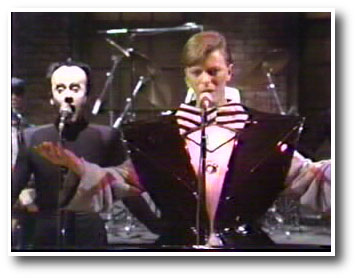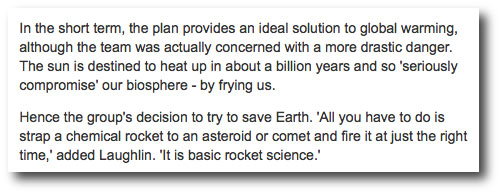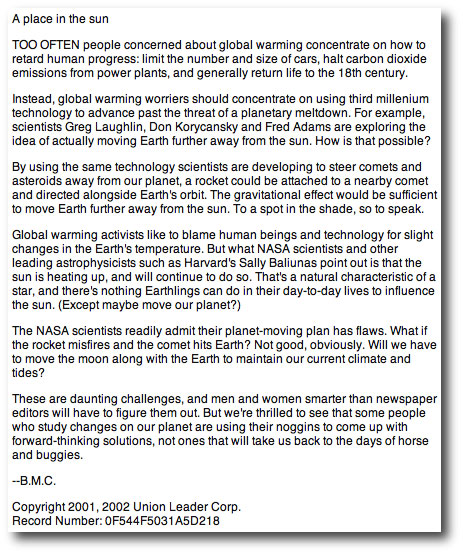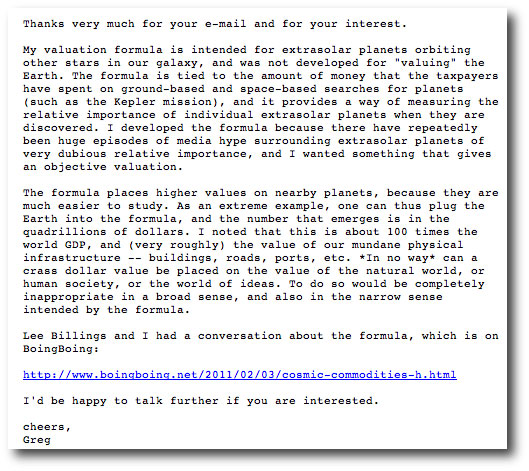Klaus Nomi and David Bowie (Image source and backstory)
I was in the middle of my dynamics lecture this past Monday morning, explaining the Fokker-Planck approximation to the collision term on the right-hand-side of the Boltzmann equation, when my phone started buzzing and vibrating in my pocket. Good thing I had remembered to turn the volume off. Without having to look at who might be calling, I knew it was likely some media outlet, BBC? KCBS? There was a sudden, all-to-familiar sensation of queasy uneasiness which made it very hard to focus on the second-order terms I had just written on the whiteboard.
Back in 2001, I naively and foolishly spoke to a reporter at the London Observer about the “relative ease” of accomplishing strictly hypothetical orbital engineering in the context of a billion-year time frame. The resulting article (now archived by the Guardian) contained an alarmingly incorrect cognitive leap from the ultra-long term to the immediate near-term:
The misconception came exactly at the time when George W. Bush was visiting Europe, explaining his position regarding the Kyoto Protocol. The Observer story became a huge, completely nightmarish story in Europe, which then echoed across the Atlantic, where it was seized upon by the Drudge Report, Rush Limbaugh and others. Here’s an example editorial from the Manchester New Hampshire Union-Leader:
For nearly a week, the story managed to survive, zombie-like through successive news cycles. Eventually, Gary Condit appeared on the scene, and finally, the media’s full attention was diverted elsewhere.
As readers likely know, I’ve been writing on this web log about a planet valuation formula, which is designed to give a quantitative assessment of whether a newly discovered planet is worthy of significant media attention. Last month, I had a detailed conversation with Lee Billings, which was published on BoingBoing as a part of Lee’s series of posts on planets (which are well worth reading!)
Several weeks after the BoingBoing article appeared, I got a very politely worded e-mail from a reporter at News of the World.
[…] I found your article on the value of the Earth which popped up on a UK blog late last week.
From what I can ascertain, your findings and formula haven’t really had the coverage they deserve in the UK media and I was hoping to rectify that…
After a look at the Wikipedia page on News of the World, my heart was pounding. “Wacko US Prof Sez: Sell Earth for 3 Quadrillion Quid!” I sat down at the computer, and it took a long time to compose a reply.
Turned out that the reporter was admirably interested in getting the story right, and the final version (which is behind a paywall) is quite fair. After all, given the possibly arch, arguably pretentious tone here on oklo.org, I did pretty much have it coming.
Predictably, newspapers in Britain saw the News of the World story and immediately picked it up. As is to be expected, successive iterations tend to lose focus on the exoplanets, and gain focus on the value of Earth. Radio stations are calling, trying to set up interviews about how much Earth is worth. Angry e-mails drift into my inbox. Google news is at 61 articles and counting.
I think it’s time to look into installing Google’s AdSense…






I offer my sympathies; as an astrophysicist who also works in a dual research-outreach role I have had my work and words twisted far beyond any reasonable comprehension. I study puslars, and when a local newspaper picked up some of our work the final story was called: Pulsars – Sailing Through Space. The emphasis on the story seemed to be heavily focussed on solar sails, which obviously have nothing to do with the energetic cores of dead stars. Unfortunately, they had linked my description of a pulsar (that is, something like a “lighthouse” in space due to the fact that it rotates to give the appearance of pulsed emissions) and immediately linked lighthouse = ships.
Unfortunately, the sensationalist ways in which the general media approach scientific stories are designed purely to grab someone’s attention as quickly as possible, and hold it for long enough to monetise every click of their mouse. Reporting on news is always secondary (or, dreadfully, tertiary) to making money.
Shouldn’t your normalization constant be increased by a factor of 10, since it appears that Kepler will find about 10x fewer “habitable” planets than the number that entered into your formula? I’m sure you’ve seen “The Occurrence Rate of Earth Analog Planets Orbiting Sunlike Stars by Joseph Catanzarite, Michael Shao” which is available on astro-ph. This seems to be quite sound work and agrees with early estimates given by the Kepler team after the Feb. data release and with back-of-the-envelope calculations done by lots of folks.
My old login had expired. I renewed it just so that I could write this:
What a joy it is to read this well written blog.
About the press problems….perhaps it is slightly better than no attention at all, especially when the journalist gets back to you and sincerely wish to get it right.
The problem is not with the journalists, but the depressingly low standard of scientific litteracy in the public. This is just directly reflected by the journalists because they too are not scientists. These things, misrepresentations like this one, happen all the time…are seriously detrimental because it forms the backbone of too many peoples exposure to the scientific world. One could hope for some kind of validation system before such stories takes on their own life but this world of ours is not perfect.